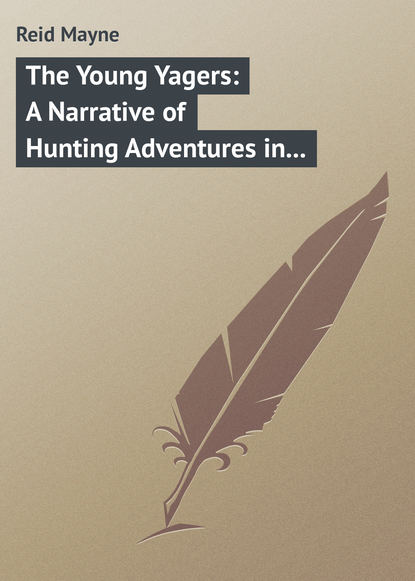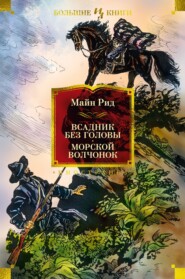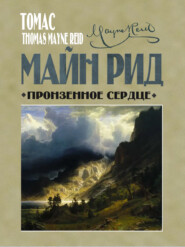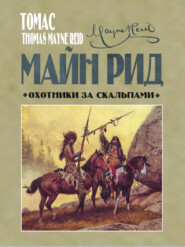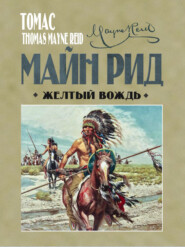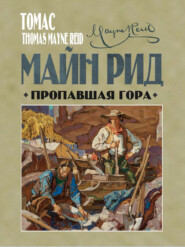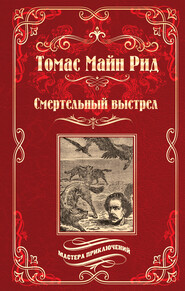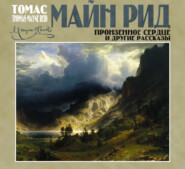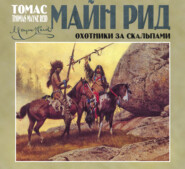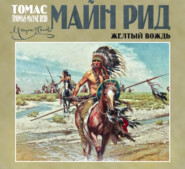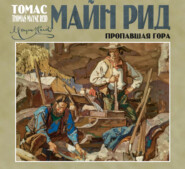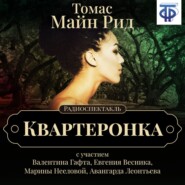По всем вопросам обращайтесь на: info@litportal.ru
(©) 2003-2024.
✖
The Young Yagers: A Narrative of Hunting Adventures in Southern Africa
Настройки чтения
Размер шрифта
Высота строк
Поля
The Young Yagers: A Narrative of Hunting Adventures in Southern Africa
Mayne Reid
Mayne Reid
The Young Yagers: A Narrative of Hunting Adventures in Southern Africa
Chapter One.
The Camp of the Young Yägers
Near the confluence of the two great rivers of Southern Africa – the Yellow and Orange– behold the camp of the “young yägers!”
It stands upon the southern bank of the latter stream, in a grove of Babylonian willows, whose silvery foliage, drooping gracefully to the water’s edge, fringes both shores of the noble river as far as the eye can reach.
A tree of rare beauty is this Salix Babylonica– in gracefulness of form scarce surpassed even by the palms, the “princes of the forest.” In our land, as we look upon it, a tinge of sadness steals over our reflections. We have grown to regard it as the emblem of sorrow. We have named it the “weeping willow,” and draped the tomb with its soft pale fronds, as with a winding-sheet of silver.
Far different are the feelings inspired by the sight of this beautiful tree amid the karoos of Southern Africa. That is a land where springs and streams are “few and far between;” and the weeping willow – sure sign of the presence of water – is no longer the emblem of sorrow, but the symbol of joy.
Joy reigns in the camp under its shade by the banks of the noble Orange River, as is proved by the continuous peals of laughter that ring clear and loud upon the air, and echo from the opposite shores of the stream.
Who are they that laugh so loudly and cheerfully? The young yägers.
And who are the young yägers?
Let us approach their camp and see for ourselves. It is night, but the blaze of the camp-fire will enable us to distinguish all of them, as they are all seated around it. By its light we can take their portraits.
There are six of them – a full “set of six,” and not one appears to be yet twenty years of age. They are all boys between the ages of ten and twenty – though two or three of them, and, maybe, more than that number, think themselves quite men.
Three of the party you will recognise at a glance as old acquaintances. They are no other than Hans, Hendrik, and Jan, our ci-devant “Bush-boys.”
It is several years since we saw them last, and they have grown a good deal since then; but none of them has yet reached the full stature of manhood. Though no longer “Bush-boys,” they are yet only boys; and Jan, who used to be called “little Jan,” still merits and receives that distinctive appellation. It would stretch Jan to his utmost to square off against a four-foot measuring-stick; and he could only manage it by standing upon the very tips of his toes.
Hans has grown taller, but, perhaps, thinner and paler. For two years he has been at college, where he has been very busy with his books, and has greatly distinguished himself by carrying off the first prizes in everything. Upon Hendrik there is a decided change. He has outgrown his elder brother both in length and breadth, and comes very near looking like a full-grown man. He is yet but eighteen years old, straight as a rush, with a decided military air and gait. The last is not to be wondered at, as Hendrik has now been a cornet in the Cape Mounted Rifles for more than a year, and still holds that commission, as may be learnt by looking at his forage-cap, with its golden embroidery over the peak. So much for our old acquaintances the “Bush-boys!”
But who are the other three that share with them the circle of the camp-fire? Who are their companions? for they are evidently on terms of companionship, and friendship too. Who are they? A word or two will tell that. They are the Van Wyks. The three sons of Diedrik Van Wyk.
And who, then, is Diedrik Van Wyk? That must also be explained. Diedrik is a very rich boor – a “vee-boor” – who every night shuts up within his spacious kraals more than three thousand horses and horned cattle, with five times that number of sheep and goats! In fact, Diedrik Van Wyk is accounted the richest vee-boor, or grazier, in all the Graaf Reinet.
Now the broad plaatz, or farm, of Diedrik Van Wyk lies contiguous to that of our old acquaintance, Hendrik Von Bloom; and it so chances that Hendrik and Diedrik are fast friends and inseparable companions. They see each other once a-day, at the least. Every evening Hendrik rides over to the “kraal” of Diedrik, or Diedrik to that of Hendrik, to enjoy a smoke together out of their ponderous pipes of meerschaum, or a “zoopje” of brandewyn distilled from their own peaches. They are, in fact, a pair of regular old comrades, – for Van Wyk in early life has seen military service as well as Von Bloom, – and, like all old soldiers, they love to repeat their camp stories, and “fight their battles o’er again.”
Under such circumstances it is not to be wondered at, that the children of both should be intimate acquaintances. But, in addition to the friendship of their fathers, there is a tie of relationship between the two families, – the two mothers were cousins, – so that the children are what is usually termed second cousins, – a very interesting sort of affinity. And it is not an unlikely thing that the relationship between the families of Von Bloom and his friend Van Wyk may one day become still closer and more interesting; for the former has for his daughter, as all the world knows, the beautiful flaxen-haired cherry-cheeked Trüey, while the latter is the father of the pretty brunette Wilhelmina – also an only daughter. Now there chance to be three boys in each family; and though both boys and girls are by far too young to think of getting married yet, there are suspicions abroad that the families of Von Bloom and Van Wyk will, at no very distant day, be connected by a double marriage – which would not be displeasing to either of the old comrades, Hendrik and Diedrik.
I have said there are three boys in each family. You already know the Von Blooms, Hans, Hendrik, and Jan. Allow me to introduce you to the Van Wyks. Their names are Willem, Arend, and Klaas.
Willem is the eldest, and, though not yet eighteen, is quite a man in size. Willem is, in fact, a boy of very large dimensions, so large that he has received the sobriquet of “Groot Willem” (Big William) therefrom. All his companions call him “Groot Willem.” But he is strong in proportion to his size, – by far the strongest of the young yägers. He is by no means tidy in his dress. His clothes, consisting of a big jacket of homespun cloth, a check shirt, and an enormously wide pair of leathern trousers, hang loosely about him, and make him look larger than he really is. Even his broad-brimmed felt hat has a slouching set upon his head, and his feldtschoenen are a world too wide for his feet.
And just as easy as his dress is the disposition of the wearer. Though strong as a lion, and conscious of his strength, Groot Willem would not harm a fly, and his kindly and unselfish nature makes him a favourite with all.
Groot Willem is a mighty hunter, carries one of the largest of guns, a regular Dutch “roer,” and also an enormous powder-horn, and pouch full of leaden bullets. An ordinary boy would stagger under such a load, but it is nothing to Groot Willem.
Now it may be remembered that Hendrik Von Bloom is also a “mighty hunter;” and I shall just whisper that a slight feeling of rivalry – I shall not call it jealousy, for they are good friends – exists between these two Nimrods. Hendrik’s favourite gun is a rifle, while the roer of Groot Willem is a “smooth bore;” and between the merits of these two weapons camp-fire discussions are frequent and sharp. They are never carried beyond the limits of gentlemanly feeling, for loose and slovenly as is Groot Willem in outward appearance, he is a gentleman within.
Equally a gentleman, but of far more taste and style, is the second brother of the Van Wyks, Arend. In striking appearance and manly beauty he is quite a match for Hendrik Von Bloom himself, though in complexion and features there is no resemblance between them. Hendrik is fair, while Arend is very dark-skinned, with black eyes and hair. In fact, all the Van Wyks are of the complexion known as “brunette,” for they belong to that section of the inhabitants of Holland sometimes distinguished as “Black Dutch.” But upon Arend’s fine features the hue sits well, and a handsomer youth is not to be seen in all the Graaf Reinet. Some whisper that this is the opinion of the beautiful Gertrude Von Bloom; but that can only be idle gossip, for the fair Trüey is yet but thirteen, and therefore can have no opinion on such a matter. Africa, however, is an early country, and there might be something in it.
Arend’s costume is a tasty one, and becomes him well. It consists of a jacket of dressed antelope-skin, – the skin of the springbok; but this, besides being tastefully cut and sewed, is very prettily embroidered with slashes of beautiful leopard-skin, while broad bands of the same extend along the outside seams of the trousers, from waist to ankle, giving to the whole dress, a very rich and striking effect. Arend’s head-dress is similar to that worn by Hendrik Von Bloom, viz: a military forage-cap, upon the front of which are embroidered in gold bullion a bugle and some letters; and the explanation of that is, that Arend, like his second cousin, is a cornet in the Cape Rifles, and a dashing young soldier he is.
Now the portrait of Klaas in pen and ink. – Klaas is just Jan’s age and Jan’s exact height, but as to circumference therein exists a great difference. Jan, as you all know, is a thin, wiry little fellow, while Klaas, on the contrary, is broad, stout, and burly. In fact, so stout is he, that Jan repeated two and a half times would scarce equal him in diameter!
Both wear cloth roundabouts and trousers, and little broad-brimmed hats; both go to the same school; and, though there is a considerable difference between them in other respects, both are great boys for bird-catching and all that sort of thing. As they only carry small shot-guns, of course they do not aspire to killing antelopes or other large animals; but, small as their guns are, I pity the partridge, guinea-hen, or even bustard, that lets either of them crawl within reach of it.
Now it has been hinted that between the hunters Groot Willem and Hendrik there is a slight feeling of rivalry in regard to matters of venerie. A very similar feeling, spiced perhaps with a little bit of jealousy, has long existed between the bird-catchers, and sometimes leads to a little coolness between them, but that is usually of very short duration.
Hans and Arend have no envious feelings – either of one another or of anybody else. Hans is too much of a philosopher: besides, the accomplishment in which he excels, the knowledge of natural history, is one in which he is without a rival. None of the rest make any pretensions to such knowledge; and the opinion of Hans on any matter of science is always regarded as a final judgment.
As to Arend, he is not particularly proud of any acquirement. Handsome, brave, and generous, he is nevertheless a right modest youth, – a boy to be beloved.
And now you know who are the young yägers.
Chapter Two.
Swartboy the Bushman and Congo the Kaffir
I have said that the young yägers were encamped on the southern bank of the Great Orange River. What were they doing there? The spot they occupied was many a long day’s journey from their home in the Graaf Reinet, and many a day’s journey beyond the frontier of the Cape Colony. There were no settlements near. No white men ever wandered so far, except an occasional “smouse,” or trader – a class of men who extend their bartering expeditions almost to the central parts of the African Continent. Sometimes, too, the “trek-boor,” or nomade grazier, may have driven his flocks to this remote place, but for all that it could not be considered a settled country. It was still a wilderness.
And what were the young Von Blooms and Van Wyks doing in the wilderness? Jäging to be sure, and nothing else, – they were simply out on a hunting expedition.
It was an expedition that had been long talked of and planned. Since their grand hunt of the elephant, the “Bush-boys” had not followed any game. Hendrik had been with his regiment, and Hans and Jan busy with their respective studies. So with Arend Van Wyk as with Hendrik, and Klaas as with Jan. Groot Willem alone, from time to time, had been jäging springboks and such other game as is to be found among the settlements. But the present was a grand expedition intended to be carried far beyond the settled part of the colony – in fact, as far as they thought fit to go. The boys had received the full sanction of their parents, and had been fitted out in proper style – each having a good horse, and each three a large wagon to carry all their camp utensils, and serve as a tent to sleep in. Each wagon had its driver, and full span of ten long-horned oxen; and these, with a small pack of rough-looking buck-dogs, might be seen in the camp – the oxen tied to the disselbooms of the wagons, and the dogs grouped in various attitudes around the fire. The horses were also fastened some to the wheels, and others to trees that grew near.
Two other objects in the camp are well worthy of a word or two; in fact, they are two individuals of very great importance to the expedition – as without them the wagons would be a troublesome affair. They are the drivers of these vehicles, and each is as proud of his whip-craft as Jehu could possibly have been of his.
In one of these drivers you will recognise an old acquaintance. The large head and high cheek-bones, with the flat spread nostrils between; the small oblique Mongolian eyes; the short curly wool-knots, planted sparsely over the broad skull; the yellow complexion; the thick “chunky” form, scarce four feet in height, and sparely clad in red flannel shirt and brown leathern “crackers;” with all these features and characters before your mind, you cannot fail to recognise an old favourite – the Bushman, Swartboy.
Swartboy it was; and, though several years have rolled over the Bushman’s bare head since we saw him last, there is no visible change observable in Swartboy. The thinly scattered “kinks” of browny black wool still adorn Swartboy’s crown and occiput, but they are no thinner – the same good-natured grin is observed upon his yellow face – he is still the same faithful servant – the same expert driver – the same useful fellow that he ever was. Swartboy, of course, drives the wagon of the Von Blooms.
Now the driver of the Van Wyk vehicle is about as unlike Swartboy as a bear to a bluebottle.
In the first place, he is above a third taller than the Bushman, standing over six feet, – not in his stockings, for he never wears stockings, but in sandals, which he does wear.
His complexion is darker than that of the Hottentot, although it is not black, but rather of a bronze colour; and the hair of his head, although somewhat “woolly,” is longer than Swartboy’s, and less inclined to take root at both ends! Where the line of Swartboy’s nose is concave, that of the other is convex, and the nose itself almost aquiline. A dark piercing eye, a row of white teeth regularly set, lips of moderate thickness, a well-proportioned form, and erect attitude, give to this individual, an aspect of grandeur and gravity, both of which are in complete contrast with the comic picture presented by the short stout body and grinning countenance of the Bushman.
The costume of the tall man has something graceful about it. It consists of a tunic-like skirt suspended around the waist and hanging down to mid-thigh. There is something peculiar in this skirt. It has the appearance of a fringe or drapery of long white hairs, not plaited or woven, but hanging free and full. It is, in fact, the true costume of a savage; and consists simply of a number of antelope’s tails – the white tails of the gnoo – strung together around the waist, and allowed to fall to their full length down the thighs. A sort of “tippet” of the same surrounding the shoulders, with copper rings on the ankles and armlets encircling the wrist, a bunch of ostrich-feathers waving from his crown, and a string of beads around his neck, complete the costume of Congo the Kaffir – for to that nation of romantic savages belonged the wagon-driver of the Van Wyks.
What! a Kaffir the driver of a wagon? you will exclaim. You can hardly realise the idea, that a Kaffir – a warrior, as you may deem him – could be employed in so menial an office as wagon-driving! But it is even so. Many Kaffirs are so engaged in the Cape Colony, – indeed, many thousands; and in offices of a more degrading kind than driving a wagon team – which by the way, is far from being considered an unworthy employment in South Africa, so far that the sons of the wealthiest boors may often be seen mounted upon the voor-kist and handling the long bamboo whip with all the ability of a practised “jarvey.” There is nothing odd about Congo the Kaffir being wagon-driver to the Van Wyks. He was a refugee, who had escaped from the despotic rule of the blood-stained monster Chaaka. Having in some way offended the tyrant, he had been compelled to flee for his life; and, after wandering southward, had found safety and protection among the colonists. Here he had learnt to make himself a useful member of civilised society, though a lingering regard for ancient habits influenced him still to retain the costume of his native country – the country of the Zooloo Kaffir.
No one could have blamed him for this; for, as he stood with his ample leopard-skin kaross suspended togalike from his shoulders, the silvery skirt draping gracefully to his knees, and his metal rings glittering under the blaze of the camp-fire, a noble picture he presented, – a savage but interesting picture. No one could blame Congo for wishing to display his fine form in so becoming a costume.
And no one did. No one was jealous of the handsome savage.
Yes, – one. There was one who did not regard him with the most amiable feelings. There was a rival who could not listen to Congo’s praise with indifference. One who liked not Congo. That rival was Swartboy. Talk of the rivalry that existed between the hunters Hendrik and Groot Willem, of that between Klaas and Jan. Put both into one, and it would still fall far short of the constant struggles for pre-eminence that were exhibited between the rival “whips,” Swartboy the Bushman, and Congo the Kaffir.
Mayne Reid
Mayne Reid
The Young Yagers: A Narrative of Hunting Adventures in Southern Africa
Chapter One.
The Camp of the Young Yägers
Near the confluence of the two great rivers of Southern Africa – the Yellow and Orange– behold the camp of the “young yägers!”
It stands upon the southern bank of the latter stream, in a grove of Babylonian willows, whose silvery foliage, drooping gracefully to the water’s edge, fringes both shores of the noble river as far as the eye can reach.
A tree of rare beauty is this Salix Babylonica– in gracefulness of form scarce surpassed even by the palms, the “princes of the forest.” In our land, as we look upon it, a tinge of sadness steals over our reflections. We have grown to regard it as the emblem of sorrow. We have named it the “weeping willow,” and draped the tomb with its soft pale fronds, as with a winding-sheet of silver.
Far different are the feelings inspired by the sight of this beautiful tree amid the karoos of Southern Africa. That is a land where springs and streams are “few and far between;” and the weeping willow – sure sign of the presence of water – is no longer the emblem of sorrow, but the symbol of joy.
Joy reigns in the camp under its shade by the banks of the noble Orange River, as is proved by the continuous peals of laughter that ring clear and loud upon the air, and echo from the opposite shores of the stream.
Who are they that laugh so loudly and cheerfully? The young yägers.
And who are the young yägers?
Let us approach their camp and see for ourselves. It is night, but the blaze of the camp-fire will enable us to distinguish all of them, as they are all seated around it. By its light we can take their portraits.
There are six of them – a full “set of six,” and not one appears to be yet twenty years of age. They are all boys between the ages of ten and twenty – though two or three of them, and, maybe, more than that number, think themselves quite men.
Three of the party you will recognise at a glance as old acquaintances. They are no other than Hans, Hendrik, and Jan, our ci-devant “Bush-boys.”
It is several years since we saw them last, and they have grown a good deal since then; but none of them has yet reached the full stature of manhood. Though no longer “Bush-boys,” they are yet only boys; and Jan, who used to be called “little Jan,” still merits and receives that distinctive appellation. It would stretch Jan to his utmost to square off against a four-foot measuring-stick; and he could only manage it by standing upon the very tips of his toes.
Hans has grown taller, but, perhaps, thinner and paler. For two years he has been at college, where he has been very busy with his books, and has greatly distinguished himself by carrying off the first prizes in everything. Upon Hendrik there is a decided change. He has outgrown his elder brother both in length and breadth, and comes very near looking like a full-grown man. He is yet but eighteen years old, straight as a rush, with a decided military air and gait. The last is not to be wondered at, as Hendrik has now been a cornet in the Cape Mounted Rifles for more than a year, and still holds that commission, as may be learnt by looking at his forage-cap, with its golden embroidery over the peak. So much for our old acquaintances the “Bush-boys!”
But who are the other three that share with them the circle of the camp-fire? Who are their companions? for they are evidently on terms of companionship, and friendship too. Who are they? A word or two will tell that. They are the Van Wyks. The three sons of Diedrik Van Wyk.
And who, then, is Diedrik Van Wyk? That must also be explained. Diedrik is a very rich boor – a “vee-boor” – who every night shuts up within his spacious kraals more than three thousand horses and horned cattle, with five times that number of sheep and goats! In fact, Diedrik Van Wyk is accounted the richest vee-boor, or grazier, in all the Graaf Reinet.
Now the broad plaatz, or farm, of Diedrik Van Wyk lies contiguous to that of our old acquaintance, Hendrik Von Bloom; and it so chances that Hendrik and Diedrik are fast friends and inseparable companions. They see each other once a-day, at the least. Every evening Hendrik rides over to the “kraal” of Diedrik, or Diedrik to that of Hendrik, to enjoy a smoke together out of their ponderous pipes of meerschaum, or a “zoopje” of brandewyn distilled from their own peaches. They are, in fact, a pair of regular old comrades, – for Van Wyk in early life has seen military service as well as Von Bloom, – and, like all old soldiers, they love to repeat their camp stories, and “fight their battles o’er again.”
Under such circumstances it is not to be wondered at, that the children of both should be intimate acquaintances. But, in addition to the friendship of their fathers, there is a tie of relationship between the two families, – the two mothers were cousins, – so that the children are what is usually termed second cousins, – a very interesting sort of affinity. And it is not an unlikely thing that the relationship between the families of Von Bloom and his friend Van Wyk may one day become still closer and more interesting; for the former has for his daughter, as all the world knows, the beautiful flaxen-haired cherry-cheeked Trüey, while the latter is the father of the pretty brunette Wilhelmina – also an only daughter. Now there chance to be three boys in each family; and though both boys and girls are by far too young to think of getting married yet, there are suspicions abroad that the families of Von Bloom and Van Wyk will, at no very distant day, be connected by a double marriage – which would not be displeasing to either of the old comrades, Hendrik and Diedrik.
I have said there are three boys in each family. You already know the Von Blooms, Hans, Hendrik, and Jan. Allow me to introduce you to the Van Wyks. Their names are Willem, Arend, and Klaas.
Willem is the eldest, and, though not yet eighteen, is quite a man in size. Willem is, in fact, a boy of very large dimensions, so large that he has received the sobriquet of “Groot Willem” (Big William) therefrom. All his companions call him “Groot Willem.” But he is strong in proportion to his size, – by far the strongest of the young yägers. He is by no means tidy in his dress. His clothes, consisting of a big jacket of homespun cloth, a check shirt, and an enormously wide pair of leathern trousers, hang loosely about him, and make him look larger than he really is. Even his broad-brimmed felt hat has a slouching set upon his head, and his feldtschoenen are a world too wide for his feet.
And just as easy as his dress is the disposition of the wearer. Though strong as a lion, and conscious of his strength, Groot Willem would not harm a fly, and his kindly and unselfish nature makes him a favourite with all.
Groot Willem is a mighty hunter, carries one of the largest of guns, a regular Dutch “roer,” and also an enormous powder-horn, and pouch full of leaden bullets. An ordinary boy would stagger under such a load, but it is nothing to Groot Willem.
Now it may be remembered that Hendrik Von Bloom is also a “mighty hunter;” and I shall just whisper that a slight feeling of rivalry – I shall not call it jealousy, for they are good friends – exists between these two Nimrods. Hendrik’s favourite gun is a rifle, while the roer of Groot Willem is a “smooth bore;” and between the merits of these two weapons camp-fire discussions are frequent and sharp. They are never carried beyond the limits of gentlemanly feeling, for loose and slovenly as is Groot Willem in outward appearance, he is a gentleman within.
Equally a gentleman, but of far more taste and style, is the second brother of the Van Wyks, Arend. In striking appearance and manly beauty he is quite a match for Hendrik Von Bloom himself, though in complexion and features there is no resemblance between them. Hendrik is fair, while Arend is very dark-skinned, with black eyes and hair. In fact, all the Van Wyks are of the complexion known as “brunette,” for they belong to that section of the inhabitants of Holland sometimes distinguished as “Black Dutch.” But upon Arend’s fine features the hue sits well, and a handsomer youth is not to be seen in all the Graaf Reinet. Some whisper that this is the opinion of the beautiful Gertrude Von Bloom; but that can only be idle gossip, for the fair Trüey is yet but thirteen, and therefore can have no opinion on such a matter. Africa, however, is an early country, and there might be something in it.
Arend’s costume is a tasty one, and becomes him well. It consists of a jacket of dressed antelope-skin, – the skin of the springbok; but this, besides being tastefully cut and sewed, is very prettily embroidered with slashes of beautiful leopard-skin, while broad bands of the same extend along the outside seams of the trousers, from waist to ankle, giving to the whole dress, a very rich and striking effect. Arend’s head-dress is similar to that worn by Hendrik Von Bloom, viz: a military forage-cap, upon the front of which are embroidered in gold bullion a bugle and some letters; and the explanation of that is, that Arend, like his second cousin, is a cornet in the Cape Rifles, and a dashing young soldier he is.
Now the portrait of Klaas in pen and ink. – Klaas is just Jan’s age and Jan’s exact height, but as to circumference therein exists a great difference. Jan, as you all know, is a thin, wiry little fellow, while Klaas, on the contrary, is broad, stout, and burly. In fact, so stout is he, that Jan repeated two and a half times would scarce equal him in diameter!
Both wear cloth roundabouts and trousers, and little broad-brimmed hats; both go to the same school; and, though there is a considerable difference between them in other respects, both are great boys for bird-catching and all that sort of thing. As they only carry small shot-guns, of course they do not aspire to killing antelopes or other large animals; but, small as their guns are, I pity the partridge, guinea-hen, or even bustard, that lets either of them crawl within reach of it.
Now it has been hinted that between the hunters Groot Willem and Hendrik there is a slight feeling of rivalry in regard to matters of venerie. A very similar feeling, spiced perhaps with a little bit of jealousy, has long existed between the bird-catchers, and sometimes leads to a little coolness between them, but that is usually of very short duration.
Hans and Arend have no envious feelings – either of one another or of anybody else. Hans is too much of a philosopher: besides, the accomplishment in which he excels, the knowledge of natural history, is one in which he is without a rival. None of the rest make any pretensions to such knowledge; and the opinion of Hans on any matter of science is always regarded as a final judgment.
As to Arend, he is not particularly proud of any acquirement. Handsome, brave, and generous, he is nevertheless a right modest youth, – a boy to be beloved.
And now you know who are the young yägers.
Chapter Two.
Swartboy the Bushman and Congo the Kaffir
I have said that the young yägers were encamped on the southern bank of the Great Orange River. What were they doing there? The spot they occupied was many a long day’s journey from their home in the Graaf Reinet, and many a day’s journey beyond the frontier of the Cape Colony. There were no settlements near. No white men ever wandered so far, except an occasional “smouse,” or trader – a class of men who extend their bartering expeditions almost to the central parts of the African Continent. Sometimes, too, the “trek-boor,” or nomade grazier, may have driven his flocks to this remote place, but for all that it could not be considered a settled country. It was still a wilderness.
And what were the young Von Blooms and Van Wyks doing in the wilderness? Jäging to be sure, and nothing else, – they were simply out on a hunting expedition.
It was an expedition that had been long talked of and planned. Since their grand hunt of the elephant, the “Bush-boys” had not followed any game. Hendrik had been with his regiment, and Hans and Jan busy with their respective studies. So with Arend Van Wyk as with Hendrik, and Klaas as with Jan. Groot Willem alone, from time to time, had been jäging springboks and such other game as is to be found among the settlements. But the present was a grand expedition intended to be carried far beyond the settled part of the colony – in fact, as far as they thought fit to go. The boys had received the full sanction of their parents, and had been fitted out in proper style – each having a good horse, and each three a large wagon to carry all their camp utensils, and serve as a tent to sleep in. Each wagon had its driver, and full span of ten long-horned oxen; and these, with a small pack of rough-looking buck-dogs, might be seen in the camp – the oxen tied to the disselbooms of the wagons, and the dogs grouped in various attitudes around the fire. The horses were also fastened some to the wheels, and others to trees that grew near.
Two other objects in the camp are well worthy of a word or two; in fact, they are two individuals of very great importance to the expedition – as without them the wagons would be a troublesome affair. They are the drivers of these vehicles, and each is as proud of his whip-craft as Jehu could possibly have been of his.
In one of these drivers you will recognise an old acquaintance. The large head and high cheek-bones, with the flat spread nostrils between; the small oblique Mongolian eyes; the short curly wool-knots, planted sparsely over the broad skull; the yellow complexion; the thick “chunky” form, scarce four feet in height, and sparely clad in red flannel shirt and brown leathern “crackers;” with all these features and characters before your mind, you cannot fail to recognise an old favourite – the Bushman, Swartboy.
Swartboy it was; and, though several years have rolled over the Bushman’s bare head since we saw him last, there is no visible change observable in Swartboy. The thinly scattered “kinks” of browny black wool still adorn Swartboy’s crown and occiput, but they are no thinner – the same good-natured grin is observed upon his yellow face – he is still the same faithful servant – the same expert driver – the same useful fellow that he ever was. Swartboy, of course, drives the wagon of the Von Blooms.
Now the driver of the Van Wyk vehicle is about as unlike Swartboy as a bear to a bluebottle.
In the first place, he is above a third taller than the Bushman, standing over six feet, – not in his stockings, for he never wears stockings, but in sandals, which he does wear.
His complexion is darker than that of the Hottentot, although it is not black, but rather of a bronze colour; and the hair of his head, although somewhat “woolly,” is longer than Swartboy’s, and less inclined to take root at both ends! Where the line of Swartboy’s nose is concave, that of the other is convex, and the nose itself almost aquiline. A dark piercing eye, a row of white teeth regularly set, lips of moderate thickness, a well-proportioned form, and erect attitude, give to this individual, an aspect of grandeur and gravity, both of which are in complete contrast with the comic picture presented by the short stout body and grinning countenance of the Bushman.
The costume of the tall man has something graceful about it. It consists of a tunic-like skirt suspended around the waist and hanging down to mid-thigh. There is something peculiar in this skirt. It has the appearance of a fringe or drapery of long white hairs, not plaited or woven, but hanging free and full. It is, in fact, the true costume of a savage; and consists simply of a number of antelope’s tails – the white tails of the gnoo – strung together around the waist, and allowed to fall to their full length down the thighs. A sort of “tippet” of the same surrounding the shoulders, with copper rings on the ankles and armlets encircling the wrist, a bunch of ostrich-feathers waving from his crown, and a string of beads around his neck, complete the costume of Congo the Kaffir – for to that nation of romantic savages belonged the wagon-driver of the Van Wyks.
What! a Kaffir the driver of a wagon? you will exclaim. You can hardly realise the idea, that a Kaffir – a warrior, as you may deem him – could be employed in so menial an office as wagon-driving! But it is even so. Many Kaffirs are so engaged in the Cape Colony, – indeed, many thousands; and in offices of a more degrading kind than driving a wagon team – which by the way, is far from being considered an unworthy employment in South Africa, so far that the sons of the wealthiest boors may often be seen mounted upon the voor-kist and handling the long bamboo whip with all the ability of a practised “jarvey.” There is nothing odd about Congo the Kaffir being wagon-driver to the Van Wyks. He was a refugee, who had escaped from the despotic rule of the blood-stained monster Chaaka. Having in some way offended the tyrant, he had been compelled to flee for his life; and, after wandering southward, had found safety and protection among the colonists. Here he had learnt to make himself a useful member of civilised society, though a lingering regard for ancient habits influenced him still to retain the costume of his native country – the country of the Zooloo Kaffir.
No one could have blamed him for this; for, as he stood with his ample leopard-skin kaross suspended togalike from his shoulders, the silvery skirt draping gracefully to his knees, and his metal rings glittering under the blaze of the camp-fire, a noble picture he presented, – a savage but interesting picture. No one could blame Congo for wishing to display his fine form in so becoming a costume.
And no one did. No one was jealous of the handsome savage.
Yes, – one. There was one who did not regard him with the most amiable feelings. There was a rival who could not listen to Congo’s praise with indifference. One who liked not Congo. That rival was Swartboy. Talk of the rivalry that existed between the hunters Hendrik and Groot Willem, of that between Klaas and Jan. Put both into one, and it would still fall far short of the constant struggles for pre-eminence that were exhibited between the rival “whips,” Swartboy the Bushman, and Congo the Kaffir.





